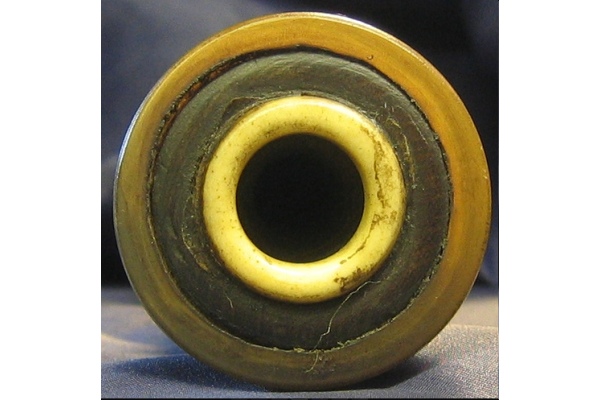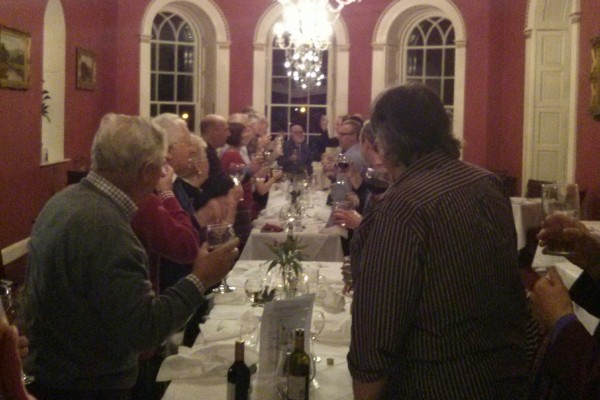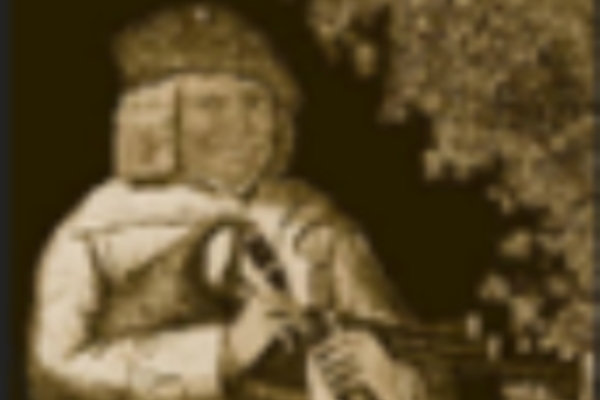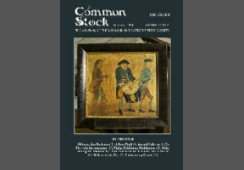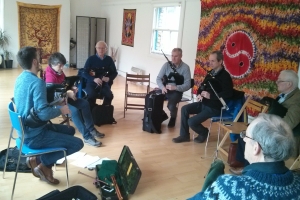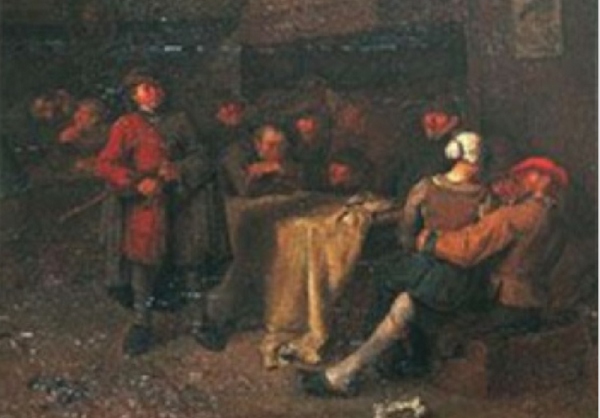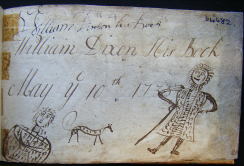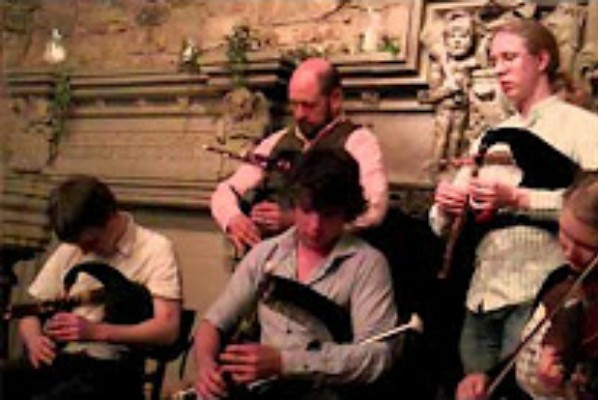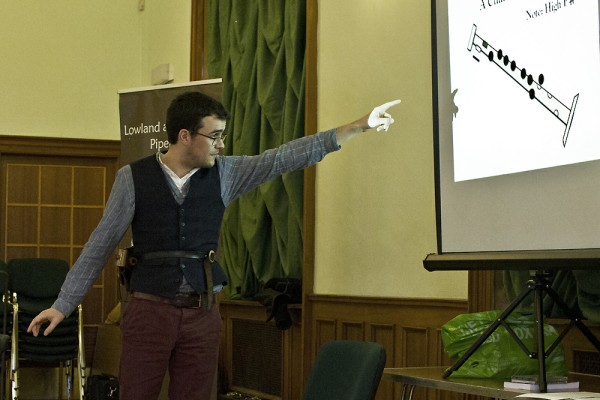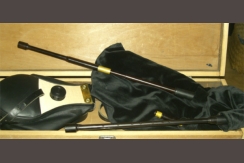A question on the LBPS Facebook Forum recently asked the question ‘is a right-hand thumbhole (for C natural) a good idea?’ This article looks at some of the nine-note tunes that require such an option.
The Henry Atkinson manuscript, dated 1694/5 contains quite a few nine-note tunes which require C naturals.. The book is one of the earliest fiddler's manuscripts to have survived, and certainly the oldest from North East England. The meticulous bowing indications make it fairly clear that this is indeed a fiddler's book, though the presence of tunes limited to a nine note range strongly suggests that these have come from piping sources. Indeed, in one or two instances these tunes exist in other sources where they have much extended ranges.
Crudds and Whey
Our first tune is of particular interest since a version appears in the George Skene manuscript of 1717 as one of the four tunes there which Skene describes as a ‘bagpipe set’. Here are five strains of Skene’s version, which he calls ‘Wat Ye What I got late Yestreen’

It has been suggested that Skene’s key signature of one sharp is an error, and this might appear to be confirmed the tune appears in a manuscript now in the NLS dated 1760 with the title Sowens and Sour Milk:

And again, as it appears in William Vickers’ manuscript 1770, where it is ‘Cruds and Cream’ (Matt suggested some edits to this in his The Great Northern Tune Book, but the manuscript itself makes sense in the context of the above version.)

And finally here is Atkinson’s version, defiantly in the dorian mode.

Crudds and Whey Henry Atkinson MS, 1694/95
The difference in titles between Northumberland and Aberdeen may see less odd after reading Robson’s ‘Northumbrian Minstrel’s Budget’, a poem cleverly constructed from a multitude of song titles, one of which is ‘And I got yesternight Curds and Whey’. Here is Atkinson’s version:
Here the C naturals make sense and the final D-E is seen to be part of a IV-V-I cadence that leads into the repeat or the following strain; the mode of the tune is A Dorian, as is the case with most of these tunes; this gives these tunes a rather different to those ‘minor’ tunes pipers are familiar with rooting in the B, which naturally create a tension between the melodic root and the A drone – here the melodic root is the drone.
Saw Ye Not My Meggy?

Atkinson’s tune is a seriously curtailed (almost to the point of emerging as a new tune) version of the tune known in Scotland as ‘Saw Ye [Nae] My Peggy’ which is in Oswald’s Book 3; here’s the first two strains of the setting in Oswald’s Book three; Oswald calls the tune ‘Saw Ye My Peggy.

I was Young and Lusty
Here is the tune from Henry Atkinson's manuscript:

This tune appears in William Dixons manuscript as Young and Lusty Was I’; Dixon’s setting is very similar in many of his strains, but it is set in the standard pipe tuning, with C sharps.
Bold Wilkinson
Atkinson has two version of this tune, one in the same mode as the foregoing (A Dorian when transcribed) and one in A mixolydian (when transcribed).

The transcriptions from the John Smith 1751 manuscript include a long variation set of this tune, with the KS pf 1 flat as in Atkinson’s original of this version. Here is Atkinson’s other version (original in Gmixolydian)

The two final tunes in this article are in the Aeolian mode – they need both C naturals and F naturals; this is rare on Scottish smallpipes, but quite practical on Lowland r Border chanters; The first is a Scots measure which is untitled in the manuscript; it is rare to find a Scots measure that remains within the nine-note range so this is something of a Border piper’s treasure: in fact, in view of the scarcity of such tunes, smallpipers with only C natural may find that played with F sharps the tune still works tolerably well, especially after playing some of the above tunes.

Untitled tune in Henry Atkinson’s Manuscript
The final tune rom Atkinson, again in the Aeolian mode, is Wheir May Our Good Man ly (or Where Shall Our Goodman Lay’ in most other sources:)

All the other known versions of this tune (with a number of different titles) are in the mixolydian or ionian modes, with the exception of Playford, who has this tune in his 1786 edition of The Dancing Master with the title ‘The Black and Grey’:

It’s worth noting that Atkinson, who has this tune notated a tone lower, in G, has two flats, but they appear only on the second stave; the other staves have no key signature. It has been argued that these ‘flats’ are just ‘scribbles’, not an indication of mode, with attention being drawn to the much more resolute Bflats in other parts of the manuscript. However, this whole tune is written in a more ‘hasty’ hand. With Playford’s precedent as evidence, I suggest that these ‘scribbles’ can be taken as a key signature, and that the tune is greatly improved by doing so.

Atkinson has a number of tunes which feature in various editions of Playford's 'Dancing master' and some which feature in 'The division violin', though he rarely seems to have copied directly, which suggests that he recorded the music from aural circulation.
[The manuscript is accessible at the Farne website; unfortunately the search facility does not allow you to scroll through the pages by the normal route; the LBPS website, in its ‘repertoire’ section contains an index to the manuscript plus instructions on how to access the individual tunes)
